When using a frying pan, food debris and fat accumulate on its inner and outer surfaces. After a while, these products are eaten into the dishes and turn into carbon deposits. It is quite difficult to deal with stubborn dirt; for this you need to select special detergents. From our article we will learn how to clean the outside of a frying pan from carbon deposits in various ways.
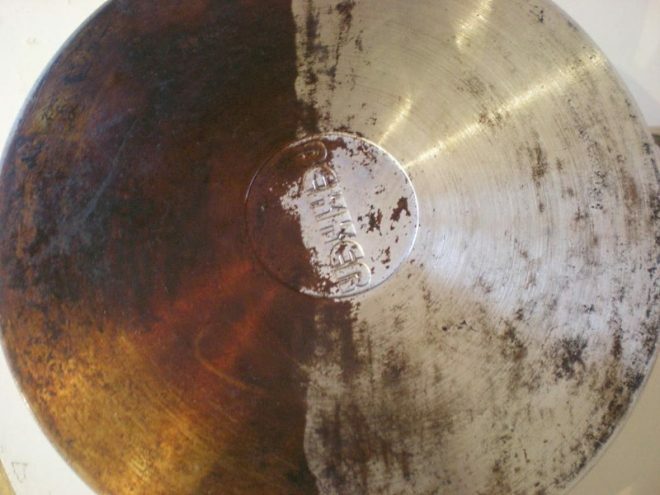
Preparatory work
At the initial stage of work, you need to decide on the material for making the dishes. Based on this, the selection of the cleaning agent, the hardness of the sponge, and also the method of washing is made. There are several options for making pans:
Attention! Earned on our website kitchen designer. You can familiarize yourself with it and design your dream kitchen for free! May also come in handy wardrobes designer.
- Aluminum and cast iron cookware does not suffer from the strong impact of coarse scourers or abrasive particles.
- Modern non-stick products require gentle, gentle cleaning. For the treatment of such surfaces, liquid solutions or special substances based on a gel are used.
- Ceramic materials have an average degree of hardness, but it is not recommended to act on them with a metal brush; it is best to remove dirt with the hard side of a foam sponge. It is also not advisable to use powders for cleaning ceramic dishes. Liquid solutions, special sprays and creams are ideal.
Before carrying out the main work, the dishes are placed in a large basin, into which warm water and detergent are poured. Soaking takes 25-30 minutes. during this time, it will be easier to peel off stubborn dirt.
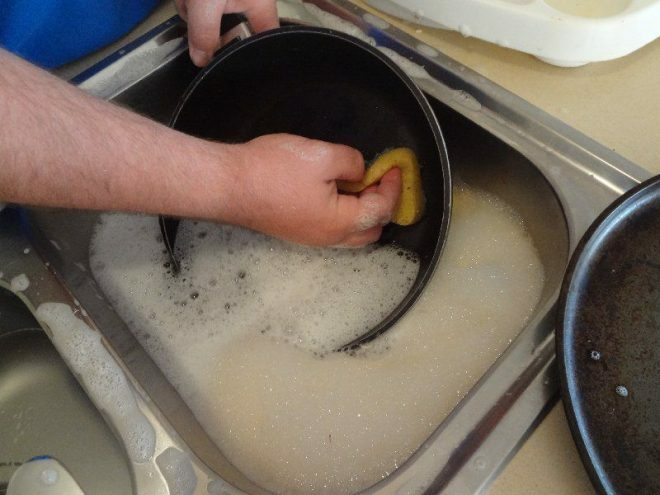
Cleaning nuances
Next, we will learn how to clean the outside of a frying pan if it is made of different materials. Depending on the type of product, a cleaning agent is selected, as well as a method for cleaning the surface.
Cast iron
Such products are not afraid of exposure to metal brushes or abrasive particles. To wash them, in most cases, folk remedies are used, for example, soda (salt) with vinegar. There are several methods for cleaning the outside of a cast iron skillet:
- With a blowtorch. The fire from this device is directed to the outer part of the dish and kept in this state for several minutes. After a while, the carbon deposits will completely collapse and lag behind the surface. A similar procedure must be carried out on the street in a specially designated place.
- How to clean the bottom of a frying pan from carbon deposits outside if the household does not have a blowtorch. For such events, an ordinary metal scraper can be useful. The dishes are calcined for some time on a fire, and then the carbon is cleaned with a metal brush. It is not recommended to use such products on other materials.
There is another method for cleaning dishes from stubborn dirt. A cast iron frying pan is placed in a metal basin, filled with water so that the liquid is completely covered and placed on a gas stove. Stationery glue, baking soda and a small amount of washing powder are added to the water. All ingredients are thoroughly mixed. It is necessary to boil the device for at least 2 hours. After that, the carbon deposits are washed off with the hard side of the foam rubber sponge.

Aluminum
Aluminum products are much softer than kitchen utensils made of cast iron, so it is not recommended to use abrasives and powder chemistry to clean the outer surface. It is better to use special gels or creams to remove dirt.
To prevent the formation of carbon deposits, the product must be constantly looked after. To do this, make a special solution consisting of 100 milliliters of stationery glue, 50 grams of soda and a bar of laundry soap (the last ingredient must be grinded first.
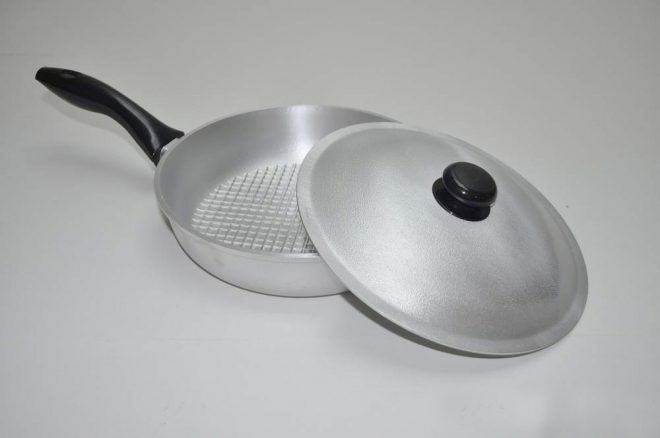
Now we will find out how to wash the outside of the pan from carbon deposits:
- These components are placed on the bottom of a large container and filled with hot water in the amount of 10 liters;
- An aluminum product with traces of carbon deposits is lowered into a basin;
- We set the container on fire and boil for 30-40 minutes;
- Leave the device to bake for 12 hours.
After a specified period of time, the surface of the dishes is cleaned with a special sponge with an abrasive substance. After such exposure, scratches appear on the surface of the product. You can get rid of them after polishing with baking soda.
There is another cleaning method, but it is used for old aluminum pots. A blowtorch or grinder with a special nozzle is also used here. Such work must be carried out outdoors, away from flammable substances.
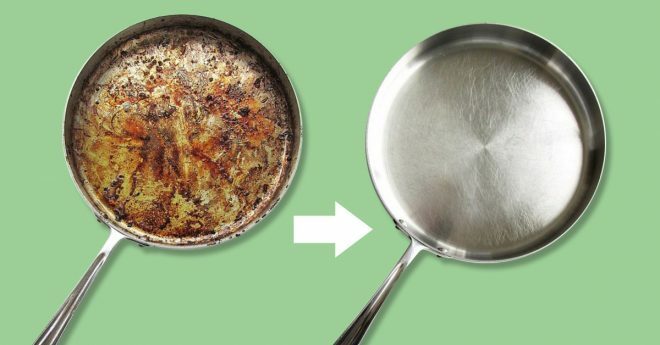
Non-stick coated products
Such pans need special care, they do not like rough handling. Set aside hard metal brushes and abrasive cleaning agents (powders) immediately. Stubborn dirt can be removed using available tools.
Non-stick Teflon pans are quite picky to maintain and do not tolerate rough handling. Therefore, you should forget about hard brushes, sponges, as well as cleaning powders. Non-old pollution is quickly cleaned by several alternative methods:
- A soapy solution will help remove carbon deposits from the outside of the pan. To prepare this substance, ¼ part of the bar of soap is rubbed on a fine grater, the ingredients are thoroughly mixed. After a few minutes add 10 grams of salt and mustard powder, as well as 2 tbsp. Spoons of ammonia. The raw materials are mixed until a homogeneous mass is obtained. The solution is applied to the outer walls of the dishes, left to stand for 20-30 minutes. After the incident of the specified time, the product is wiped with a foam rubber kitchen sponge.
- You can remove stubborn stains on non-stick surfaces with potato starch. To prepare a solution, 100 grams of the specified substance is diluted in 2 liters of water. The dishes are placed in a basin, filled with solution and boiled for 15-20 minutes. After cooling, the carbon deposit will well lag behind the surface, it is cleaned off with a foam rubber sponge.
When cleaning the surface, you do not need to make any special efforts, prolonged friction in one place leads to the destruction of the Teflon coating. If it is not possible to achieve the desired result in one go, the procedure is repeated.
Stainless steel
Not every housewife knows how to wash pots and pans from the outside if they are made of stainless steel. In this case, the dirty bottom of the cutlery must be placed on a steam bath (water is diluted with vinegar in equal proportions). Put the pot with the liquid on the fire, bring to a boil.
When the water boils, a frying pan is placed over the pan so that the vapors pass over its surface. Duration of bottom treatment is within 10-15 minutes. After that, the dishes are removed from the steam bath. Take a soft cloth and put a mixture of table salt and soda there. This composition is used to wipe the bottom of the device. When natural ingredients are mixed, a rather aggressive mixture is obtained, therefore, the surfaces of the frying pan are treated with rubber gloves.
Potatoes are used to make stainless steel dishes shine, rub the surface of the appliance with a slice of this vegetable. Lemon juice or vinegar can be used instead of potatoes. These ingredients are applied to a napkin and the wiping begins. After processing, rinse the pan with water.
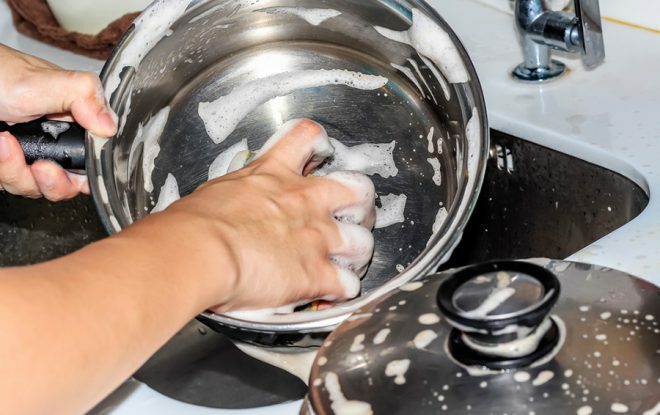
Useful Tips
We learned how to clean the outside of the frying pan from carbon deposits, but each material needs its own individual product. Now let's get acquainted with a few tips regarding the use of such dishes:
- Ceramic products are afraid of sudden temperature fluctuations; they must cool completely before cleaning or rinsing with cold water.
- The non-stick coating can be damaged by cleaning with sharp objects or abrasives. Use wooden spatulas or silicone products to stir food. Steam this cookware several times if necessary.
Use scouring powders or harsh sponges only when absolutely necessary. This mainly applies to ceramic dishes and teflon-coated products.
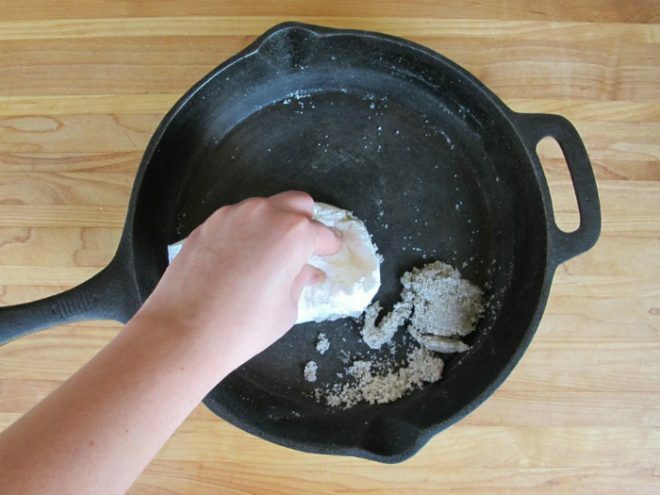
Conclusion
With proper and timely care, any pot will serve its owner for more than a dozen years. The main thing is to clean the devices from carbon deposits and traces of fat in time, and then the dishes will delight you with their cleanliness and tasty food.


